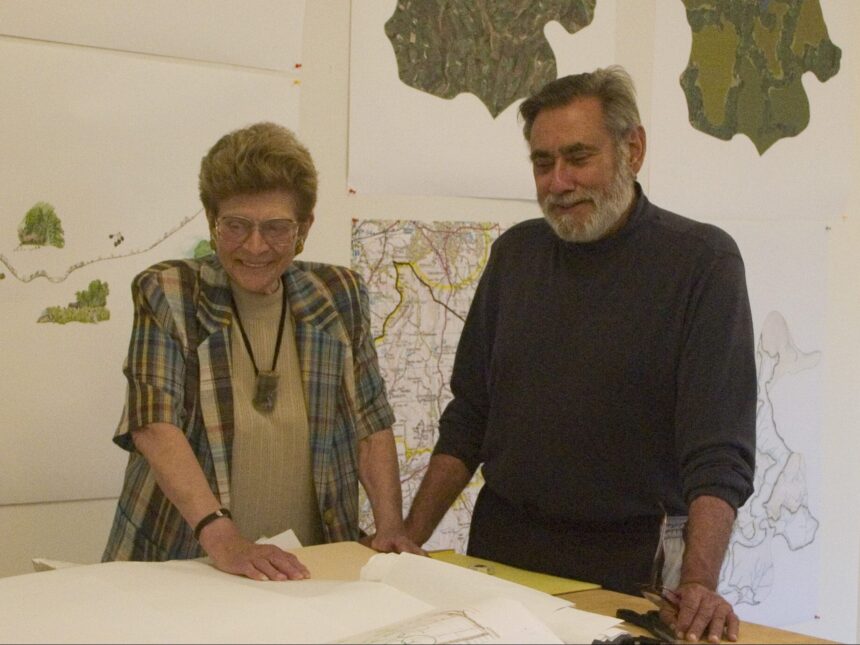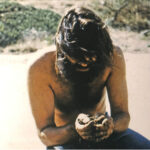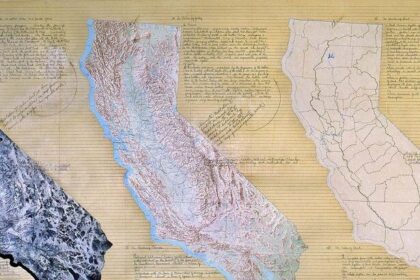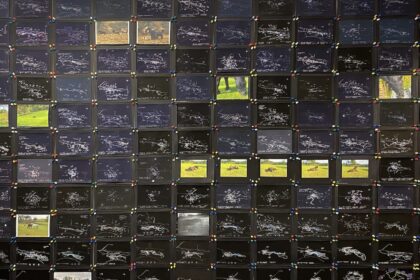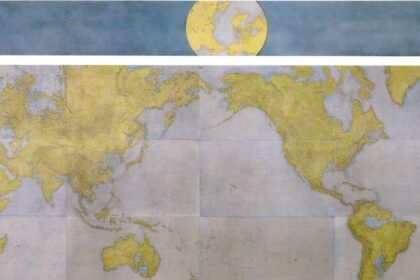“Thinking with” the Harrisons: What Does Now Demand?
Anne Douglas and Chris Fremantle
The reversal of entropy requires considerable energy and imagination and is accompanied by risk.[1]

This statement from the designer, planner and ecologist Frederick Steiner evokes the core challenge of the current environmental crisis: the energy that is required for every field of endeavor to rethink itself both in relation to itself, and to other knowledges and practices. The risk involves coming to terms with uncertainty and with the realization that this act of re-thinking will require us to challenge established ways of knowing and living. Helen Mayer Harrison (1929-2018) and Newton Harrison (1932-2022), “the Harrisons,” have for over fifty years pioneered a practice that is focused by ecologies and have sought to engage in precisely such a re-thinking. They have explored ecosystems in different ways and at different scales, firstly in quasi-scientific experiments, then in watersheds and bioregions, and eventually at a continental scale. Entropy has been a key organizing concept in this work, particularly since 2007 in the Force Majeure projects.
We believe that present day capitalism, unless it finds the way to give back to the life web more than it takes, by internalizing biological exchange, will continue to generate this sixth extinction and the overarching simplification and further degeneration of the web of life. The partial collapse of the life web is highly probable, as demonstrated by the physical laws of the conservation of energy. We know that when energy is changed from one form to another there is always a net loss, thermodynamically expressed as entropy. [2]
A healthy low entropy system is one where the transformations of energy (the processes of living, reproducing and dying) mean that energy in the system can continue to work, in other words that energy is not dispersed, becoming unusable and inert. Nature constantly reuses waste (biological exchange) whereas humans have not prioritized this, resulting in the simplification and degeneration of the web of life. We face a “force majeure” i.e. we have created the circumstances, in terms of population explosion, an energy consumption explosion and runaway economic development, which can only be characterized as a high entropy system resulting in the sixth extinction. In a playful reversal of the meaning of force majeure as an “escape” clause, the Harrisons propose that there is no escape as long as we continue along the current trajectory of creating high entropy systems. [3] The escalating environmental crisis is the context that makes the Harrisons’ work over the past fifty years particularly prescient. The speed and scale of change is now a matter of scientific fact that in turn generates matters of shared concern for how to imagine and organize a common future. High entropy, as Steiner and the Harrisons recognize, is a useful way to understand the underlying problem as it characterizes the consequences of not thinking ecologically.
It is noticeable that many ecological scientists are increasingly turning to the arts to help society to think through how best to move forward. In a recent collaboration between the philosopher of science, Bruno Latour and the curator of arts and media, Peter Weibel in 2020, Latour suggests we are no longer equipped to deal with the terrifying news of environmental devastation. He appeals to fellow scientists to rethink what they might expect from the arts as something more than popularization and ornamentation, indicating that the arts can be an important contributor to understanding and acting in the world differently. He is joined by contemporaries such as Donna Haraway, Isabelle Stengers and Anna Tsing, in turning towards artists as public intellectuals in a far-reaching reappraisal of what it means to be human. Haraway, a feminist in the biological sciences, increasingly uses creative writing as an opening up to a more than human world. Tsing, an anthropologist, investigates life “in the ruins” through the experiences of mushroom pickers improvising their existence in the margins of mainstream society. The mushroom economy forms a powerful image of a dystopian future. Stengers, like Latour, is a philosopher of science in search of a different science, one that is freed from the dictates of capitalist interests, free to ask questions that matter to the future of humanity. These scientists parallel the Harrisons in focusing on the wellbeing of ecosystems and in acknowledging that aesthetics has an important role to play in encouraging a different way of imagining what it means to be human from an ecological perspective.
It is to Stengers and her major undertaking to “think with” the mathematician and philosopher, Alfred North Whitehead, that we predominantly turn to reappraise the Harrisons’ work in light of these significant and profound developments. Stengers and others’ interest in Whitehead is because his process philosophy has been critical to the development of ecological thinking beyond the narrow confines of the biological sciences, just as the Harrisons have sought to shape a form of art and aesthetics beyond the narrow confines of the art institution. Whitehead’s idea of a process philosophy and the Harrisons’ notion of ecological art have both been important in enabling an idea of ecological thinking to move into and contribute to other disciplines and practices.[4] Before embarking on this venture, it is important as a first step to reflect on what the arts to date have specifically offered to social environmental challenges. Galafassi et al. in their sociological analysis of this issue draw on a range of case studies and reveal a wide range of possibilities.[5] Artists can communicate science in ways that extend its reach, a function not far perhaps from Latour’s notion of “popularization”. They can open up the imagination to serendipity and develop forms of experimentation that are different from positivist science and that explore futures imaginatively. They can embrace the complexity of emotions and values that confront human beings and construct spaces of interaction engaging the human and non-human in processes of knowledge exchange and civic participation. These largely positive qualities of the arts are tempered by writers such as Amitav Ghosh, who, as a writer of fiction and non-fiction, raises questions about what form of art serves the challenges we face appropriately. Ghosh questions whether the modern western novel and its particularly narrow focus on the subjective experiences of individual characters can sufficiently address the scale of the issues involved in environmental change.[6] As a form the novel may in fact depend upon an assumption of ecological stability and therefore exacerbate the problem. Such examples across the arts and humanities reveal a restless search for a different future, one that is wide-eyed to the challenges we face but also refuses to be crushed by the overwhelming evidence of the speed and criticality of the change, and the need for rapid forms of adaptation against time.
Why are the Harrisons important to this discussion? For some contemporary artists like Ghosh the environmental crisis emerges as something of an intrusion in thinking and being that challenge their ways of working and the institutions that support them and their audiences. The Harrisons also experienced the intrusion, Newton as an established gallery artist and Helen as a Chaucer scholar and educationalist. They committed to addressing the environment in response to profound, personal and disruptive experiences, including reading Rachel Carson’s Silent Spring, which explored the effects of DDT on biodiversity.[7] Over fifty years they painstakingly evolved a form of practice in which environmental well-being is front and center, simultaneously subject, content and process. They have had to reinvent themselves as individuals and create a way of working appropriate to their commitment to only make work that would help them understand the web of life and its needs, not the narrow interests of humans alone. Their work is open to the world and its mutability. It is in their terms post-disciplinary, led by circumstances on the ground. It is situated in the sense that they begin in particular places and raise questions in response to what they find through conversation. They create opportunities for discourse and the sharing of knowledge and experience in which the voice of the farmer or birdwatcher is as relevant as that of the expert scientist. They become saturated in knowing a place and connect place with ecological systems, creating feedback loops that allow for new learning. They describe their process as a form of “conversational drift”, a key concept underpinning the work’s 50-year evolution. It is through conversational drift as a process that is informed and open-ended, participatory and generative, that they tackle the challenge of high entropy systems. Importantly, this approach stimulates and provokes emotional intelligence and the energy to rebuild a world in common through the coming together of plural, potentially contradictory perspectives. These characteristics, carefully developed as a practice that is profoundly aesthetic, poetic and artistic, find interesting parallels in the ways the scientists mentioned above are currently rethinking science and its relevance to the future of the planet. In this essay we are going to focus on the early works known as the Survival Pieces (1971-74) because it is in these early works that the Harrisons’ practice is first formed through a process of open-ended experimentation. In these early works, the taking of risk is palpable, at times giving way to a degree of chaos from which new learning and different priorities emerge. The Survival Pieces offer a critique of industrialized systems that seek to control, reducing uncertainty to a minimum. Each work is concerned with how we feed ourselves and attempts to reveal co-dependence in natural systems in the way organisms live, reproduce and die, enabling the energy of the system to continue to work.
Why have we chosen to work with Stengers’ thinking with Whitehead as a way of reappraising the Harrisons’ work? As authors we have written on the Harrisons’ practice from a diversity of perspectives: on metaphor, on improvisation, on inconsistency and contradiction, as a poetic form, in relation to policy and governance, and in relation to irony and the absurd.[8] Our research to date has largely addressed artists and their audiences interested in exploring new forms of artistic practice. We have explored how the Harrisons work with scientists and the relationship between their work and environmental policy and governance. In this article, we read more deeply into the philosophy of science and have uncovered shared concerns that point to an underlying commonality between the domains of science and art. By connecting these diverse bodies of work, Stengers/Whitehead in science with the Harrisons and related thinkers in art, noting synergies and contradictions, it becomes possible to encounter and cross fertilize a plurality of perspectives that have hitherto been siloed. This article explores this commonality and its implications for making a “world in common”. It explores the implications for a different aesthetic, an ecological aesthetic as Steiner defines it, one that is more than a sensory exchange between people and their environments. An ecological aesthetic, he argues, is capable of taking into account socio-cultural and political interrelationships countering entropy by working with the organization, structure and function of ecosystems, understood through aesthetic as well as analytic means.
“Thinking With”
The approach of “thinking with” is not unique to Stengers. A number of writers, including Hannah Arendt, have worked with this concept to forge a different pathway with past and current experience that is neither writing a history nor producing models that can be applied uncritically. “Thinking with Whitehead today,” as Stengers writes “therefore means accepting an adventure from which none of the words that serve as our reference points should emerge unscathed but from which none will be disqualified or denounced as a vector of illusion”.[9] Stengers stresses the rigorous listening she has undertaken in relation to Whitehead. She has offered us as authors a way to tack very closely as far as we can to the Harrisons’ work as it is practiced and as it is articulated. Stengers’ construction of thinking with Whitehead, as a rigorous but open-ended process, provides a way to think about responding to the Harrisons and the potential for aesthetics to help us to make sense “in common”. For us it has provided a point of entry into learning and resonating with their work(s).
Both Stengers and the Harrisons share the recognition that the time is now over to imagine the Earth as a totality of resources available for our use. Stengers draws on a series of concepts established by Whitehead that we have found resonant in our exploration of the Harrisons. Stengers begins with Whitehead’s concept of the “bifurcation of nature” as a splitting of ways of knowing between a world constructed by science that is not accessible to the senses and the world available to us in everyday experience through our sensory apparatus. This is a split that Stengers is seeking to overcome in the development of a more responsible and responsive form of science. Overcoming this split involves a “leap of the imagination,” a term Whitehead himself used to counter the forces of consensus and verification in science that necessitate the agreement of all competent colleagues before a hypothesis can become thesis. Assuming plurality in the building of “a world in common” is different in that complexity and contradiction are always present, not rationalized or ironed out. Instead of resisting objections, a leap of imagination is propositional and raises questions such as: what does this proposition do to thought, what does it render important and what does it render silent? “Inventing a field” is a temporary device to situate the artist, scientist or researcher within their inquiry, acknowledging the artificiality but necessity for constraints. “Adventure” openly acknowledges the daring required to break through the bounded, policed and self-interested research cultures of capitalism, to be prepared to raise questions that reach beyond such confines. “Story telling” in both Stengers/Whitehead and the Harrisons is a way to understand experience through a unique perspective, setting limits or enabling constraints to experience in ways that help us to make sense of the world. Stengers’ reading of Whitehead begins with a story, John Gardner’s retelling of Beowulf from the perspective of the dragon hero, Grendel, who attacks human beings for their apparent stupidity in believing the stories they tell themselves.[10] It is the blind poet (the Blind Ork in the story) who shows Grendel that stories function in multi-faceted and contradictory ways, rarely landing on a single truth.
The Bifurcation of Nature
What Stengers sees in Whitehead is a serious attempt to rethink the bifurcation of nature by acknowledging that more than one way of knowing is important for the furthering of life. The separation of explanation and understanding in the production of “facts” (the world constructed by science) from meaning and values (the world of aesthetics, the senses and perception) is problematic, she argues, because it has given rise to highly successful forms of techno-science that in turn have brought about human alienation from the conditions on which our lives depend. As a result, we find ourselves valuing high entropy systems and the associated characteristics (the great acceleration in population, energy consumption and runaway economic development) without taking the responsibility to address the consequences. Stengers suggests that part of the problem of bifurcation is that science has confined itself to “how?” questions since the Renaissance. She highlights the separation of “how?” questions from “why?” questions, and the ways in which “why?” questions, such as “What has happened to us?” are never allowed to be addressed.
This was the sense in which Galileo proposed to distinguish between what he had succeeded in demonstrating, “how” bodies fall, and the question of “why” they fall in that way, a question which, as he remarked, there was “no great use” in asking: this is the domain of the imagination and of undecidable fiction. [11]
Helen and Newton, in discussion with Michael Auping, curator of Five Artists in the Florida Landscape in 1982, directly address this same issue in terms of fragmentation, reiterating Whitehead’s bifurcation.
NH: We see modernism as beginning with the Renaissance. We see modernism as the successive division into smaller and smaller categories, of all human knowledge. The operant being that the establishment of micro categorization permits a clear perception of individual phenomenon and therefore, deeper understanding.
Helen amplifies the dangers in saying:
HH: We feel that we know more about something out of the context in which that something occurs leads to less and less understanding of the something since everything exists in context. I consider this one of the great problems of our culture…we have so much information and yet so little understanding. Indeed, modernism reflects the conditions that separate people from the ground they stand on. It is a power and control centered belief-system in immediate need of revision, particularly of its guiding metaphors. [12]
The parallels between the Harrisons’ articulation and that of Stengers/Whitehead is striking.
A Leap of Imagination
In thinking with Whitehead, Stengers draws on Whitehead’s concept of a “leap of the imagination” as a way to overcome the bifurcation.
It isn’t just taking the leap – it is experimenting with the effects of the leap. . . what it does to thought, what it obliges one to do, what it renders important, and what it makes remain silent. [13]
She also asks,
. . . how is the contrast between success and defeat defined for it [the adventure that follows the leap]? [14]
We see Helen and Newton’s leap of the imagination, here expressed as initiating a trajectory of development, captured in this statement
. . . [the] progression from an initial decision, made in ’69-’70, to do no work that did not in some way look at ecosystemic well-being. [15]
There are many different articulations of this, not least in Serpentine Lattice (1993) where it is proposed in terms of figure and ground. Serpentine Lattice is a work that explores the damage to the environment caused by clear-cutting practices in the Pacific Northwest Temperate Coastal Rain Forest, proposing ways to restore the forest.
THEN
A NEW REVERSAL OF GROUND COMES INTO BEING
WHERE HUMAN ACTIVITY BECOMES A FIGURE
WITHIN AN ECOLOGICAL FIELD
AS SIMULTANEOUSLY THE ECOLOGY CEASES T0 BE
AN EVER SHRINKING FIGURE
WITHIN THE FIELD OF HUMAN ACTIVITY [16]
The Harrisons initially talked about their commitment to the well-being of the web of life in terms of conceptual art strategies.
One of the tenets of conceptual art, which strongly influenced our conceptual artmaking, was to make a single decision and follow it relentlessly to its unknown, unknowable outcomes. The outcomes were simply the result of continuous creativity, investigation and enactment, referenced always to that initial single decision. [17]
What difference does this leap of imagination make? Survival Piece #II Notation on the Ecosystem of the Western Saltworks with the inclusion of Brine Shrimp (hereafter ‘Shrimp Farm’) is one of a cluster of works from 1971, a highly productive and experimental year in which the foundations of the Harrisons’ approach emerged through a process of trial and error. The cluster included the piece Part One of an Ecological Nerve Center in the exhibition Furs and Feathers in New York as well as four Survival Pieces, including Survival Piece #I Air, Earth, Water, Interface: Annual Hog Pasture Mix; Survival Piece #2 Shrimp Farm, Survival Piece #III Portable Fish Farm; and Survival Piece #IV La Jolla Promenade.
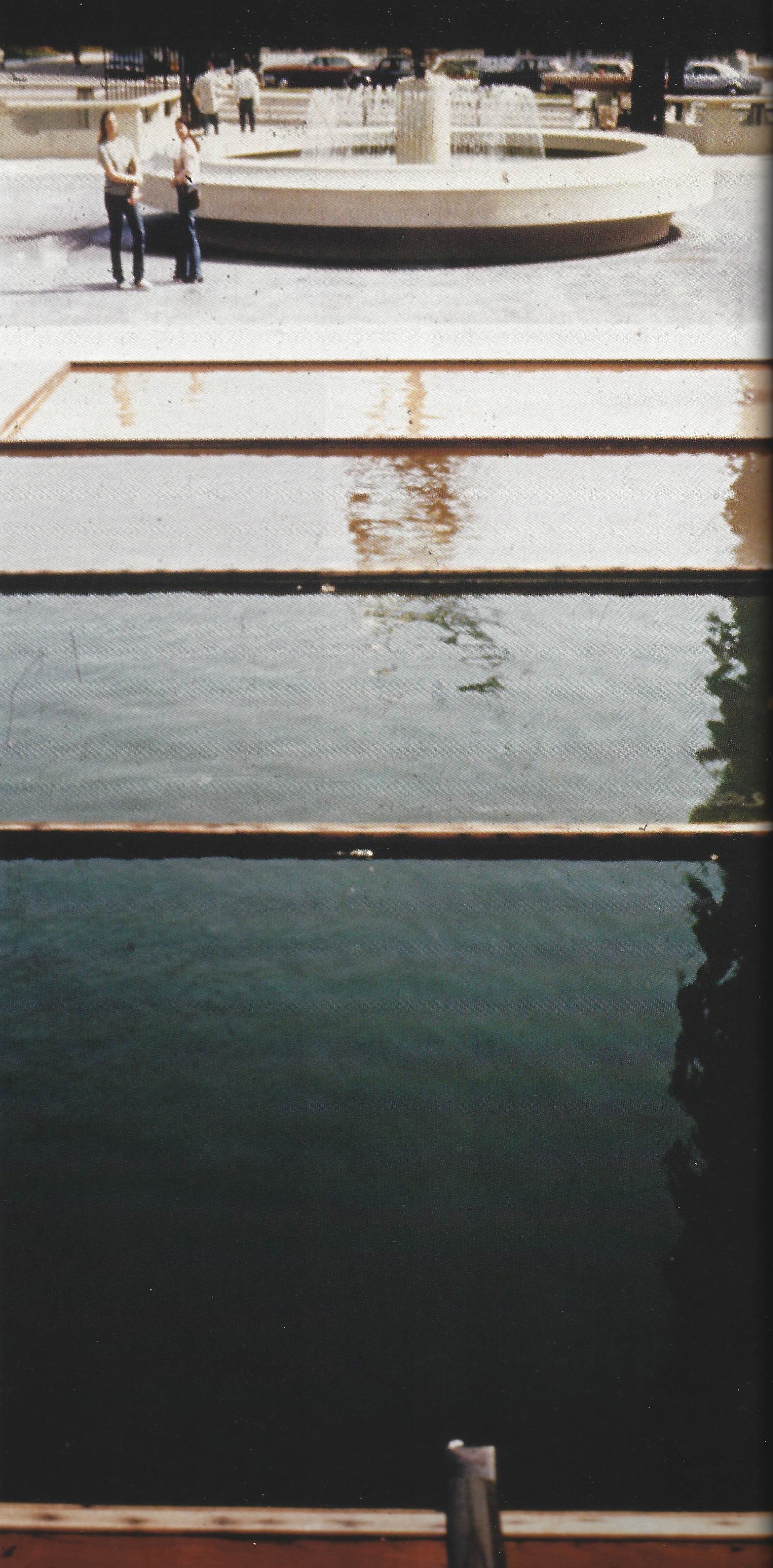
Shrimp Farm takes the form of what Newton calls a Dadaist gesture. [18] It involved four large ponds outside the Los Angeles County Museum of Art (LACMA), each of which had a slightly different combination of an ecosystem of brine shrimp and algae. This was the first work which included a “feast”, a significant dimension of the Harrisons’ work as we shall see. The work brings together two widely separate realities, that of modernist art with that of a living system. It could be read on the one hand as a color field, and on the other as a shrimp farm. The co-existence between these two phenomena creates a spark that disorientates and deprives us of a familiar frame of reference.

Returning to Stengers, the implications of the leap of the imagination that Stengers/Whitehead make is that problems arise out of experience, that they are worked and developed through experience. There is a direct resonance with the Harrisons here. Shrimp Farm (along with the other Survival Pieces) is an open-ended experiment that is speculative. Collectively the Survival Pieces are generated by a question: How do we feed ourselves? This is a question that comes out of everyday life. Each work constitutes an experiment and an experience, for the artists, for the curators and for the audience. Stengers uses experiment in the French sense which includes the idea of experience overtly. She says,
Unlike French, English does not allow the word “experiment” to be used for an experience that implies an active, open, and demanding attention. [19]
We could equally say that the Harrisons’ Survival Pieces and subsequent work constitute an experiment in these terms, i.e. one that requires an active, open and demanding attention in which we are never not involved. For Stengers the problem with the English construction of “experiment” is that it denies interdependence. Our thinking with the Harrisons is, like Stengers’ relation with Whitehead, an experiment/experience with that question “What has happened to us?” In this sense, the Shrimp Farm exposes the absurdity of high art being celebrated at the cost of the ecosystem. The foundational question of survival and what it takes to feed us then obliged Helen and Newton to harvest the system and create a feast, albeit inedible in this case. This is a pivotal point. It created a transformation in their way of working where one set of concerns (the Plasma works which Newton was also exhibiting) are superseded by questions for both Helen and Newton of survival and the process of understanding how living systems work.
Inventing a Field
For Stengers/Whitehead and the Harrisons, problems come out of situations and entail the invention of a field in which the problems might find a solution. “Field” for Stengers/Whitehead and for the Harrisons is a temporary device creating space for composition and imagination. The foregrounding of experience, whether it is of an artwork, or the world itself, necessitates that we open ourselves up to ongoing living and dying. Shrimp Farm draws attention to dependencies: human > nutrient > algae > shrimp > human. The co-dependence between problems and corresponding fields is generative of situated knowledge. This is often understood as “place-based’ knowledge.”
Instead of making organizational decisions based on mere technical knowledge, ‘which removes the knower from the process of knowing’, embededness is related to situational knowledge that comprises first-hand experience of local ecosystems. [20]
The way that Stengers/Whitehead construct situated knowledge is closely aligned with what we perceive in experience, i.e. a world that is given to us through the senses more than one that is read through models or paradigms. Situated knowledge always brings together time and space in an event. The Harrisons approach this through their questions, “How big is here?” and “How long is now?”. These two questions engage the plasticity of scale and time in the placing of boundaries as a core part of their process of inventing a field which they describe as a “field of play”. One of the earliest examples of this is Meditation on the Great Lakes of North America (1977) which defines the field by the ecological integrity of the Great Lakes region, rather than by the national, state, and county boundaries. This constitutes a profound provocation to what sort of world in common we might imagine; one based on the conventions of sovereignty, or one which recognizes ecological coherence and interdependence as the underpinning of a different social and political coexistence.
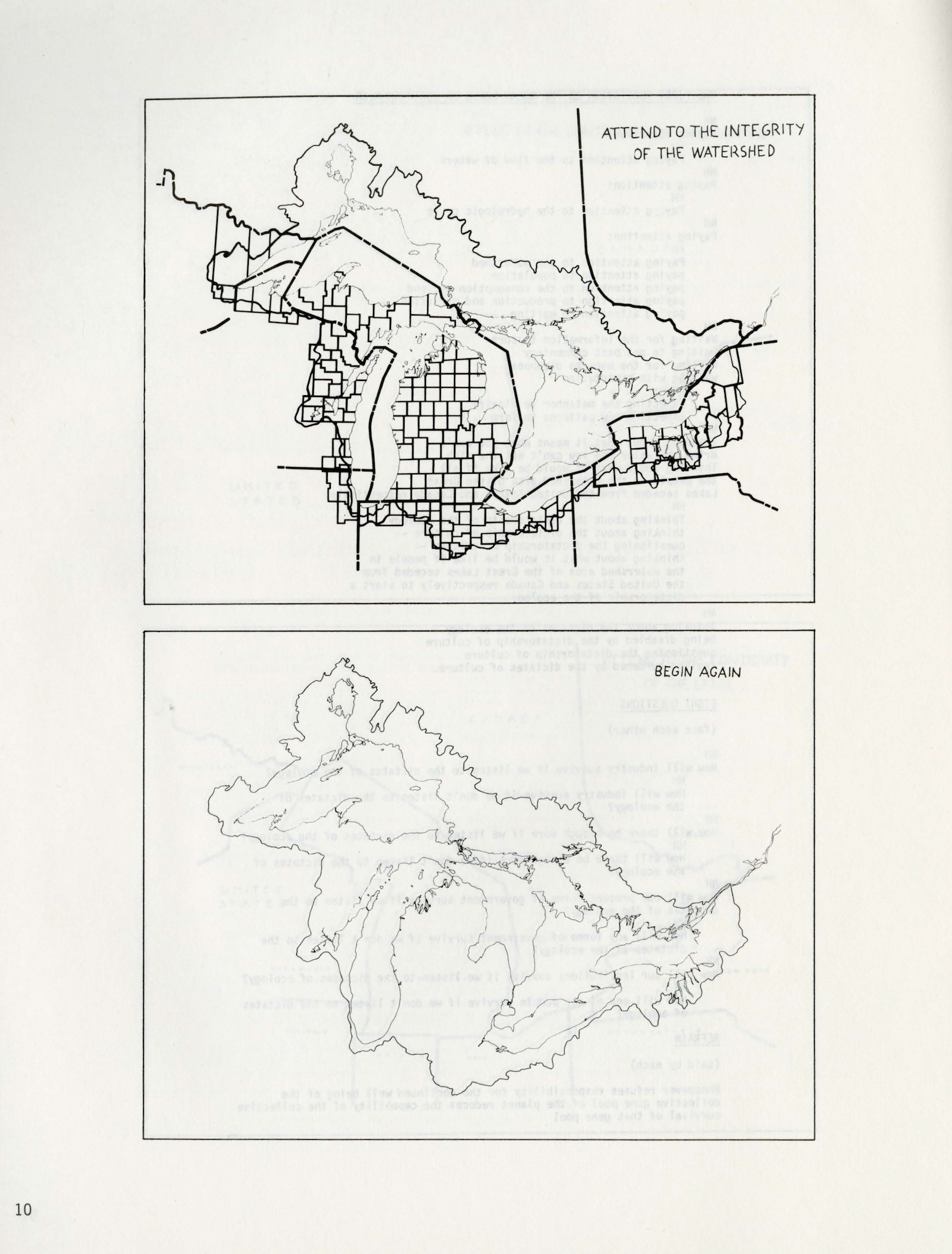
Adventure
These elements–the overarching problem of the bifurcation of nature, the leap of imagination required to avoid being trapped in known ways of thinking–sets up an adventure in which as Stengers says “. . . none of the words that serve as our reference points should emerge unscathed”. [21] This notion of adventure gives us the freedom to tackle issues/problems that have otherwise been marginalized: in this case foregrounding the well-being of the web of life against the narrative of progress, asking the question of survival. However, an adventure does more than highlight questions or problems: it allows us to enter into the dynamicity of being, or as Stengers puts it, to become part of the world in its making. She imagines thinking as entering into the mobile reality of this unfolding world, following its curves and adopting the movements of its inner life.[22]
What is “adventure” in the Harrisons’ works? Each of the Survival Pieces, one could argue, constitutes an adventure, increasingly finding ways to draw us in as interlocutors and enabling us to feel the interdependencies within living systems. Where Shrimp Farm intentionally used absurdity to highlight such interdependencies, subsequent works develop more and more ecologically complex systems and become generative of contradictions. Contradictions are in turn generative for the Harrisons, constitutive of a different form of practice. Contradictions reveal the points of tension between conflicting values and beliefs in culture and society.[23] Stengers’ questions have helped us to see some of the nuances of this more clearly. This is well exemplified with Portable Fish Farm: Survival Piece #3 which unintentionally became read as a work of ‘shock’ art.[24]
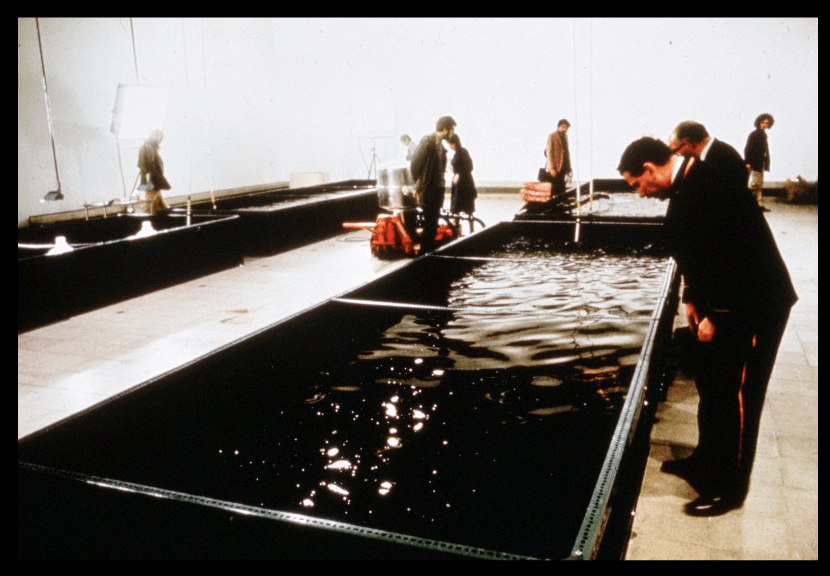
This was an experiment which to a lot of people looked like science or fish farming. It involved a series of tanks installed in the Hayward Gallery, London (and later other venues). The tanks provided habitats for catfish and bottom feeders at different stages of development. The intention was to have a system in which the catfish reproduced. As with Shrimp Farm, human dependence was built in, both in terms of care of the system—it needed to be looked after; and in terms of sustenance—it did produce fish for feasts.
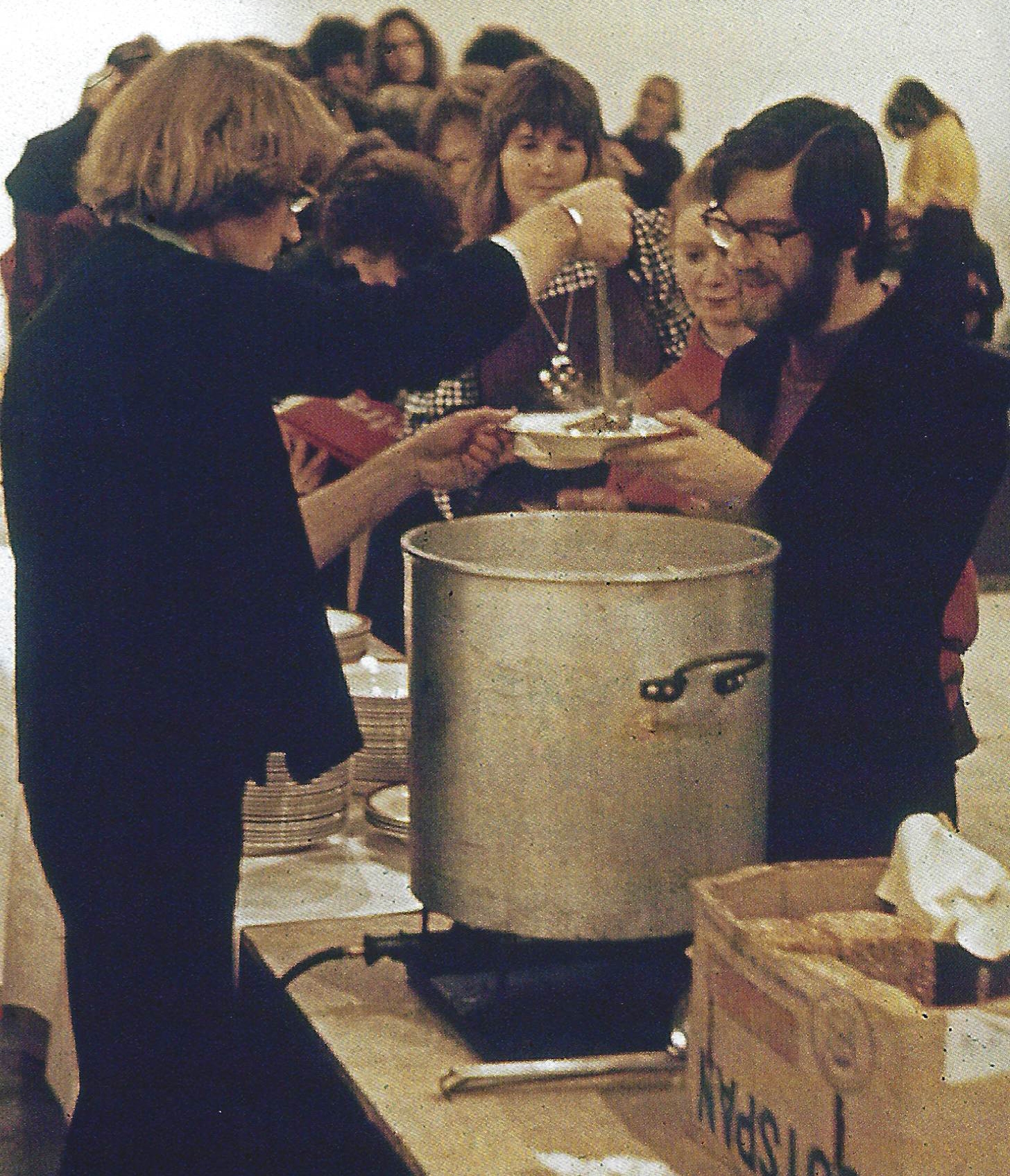
The first of the contradictions that emerged was between American and British values around catfish. In the United States catfish farming was a growth industry, and in the United Kingdom some species of catfish were pets.
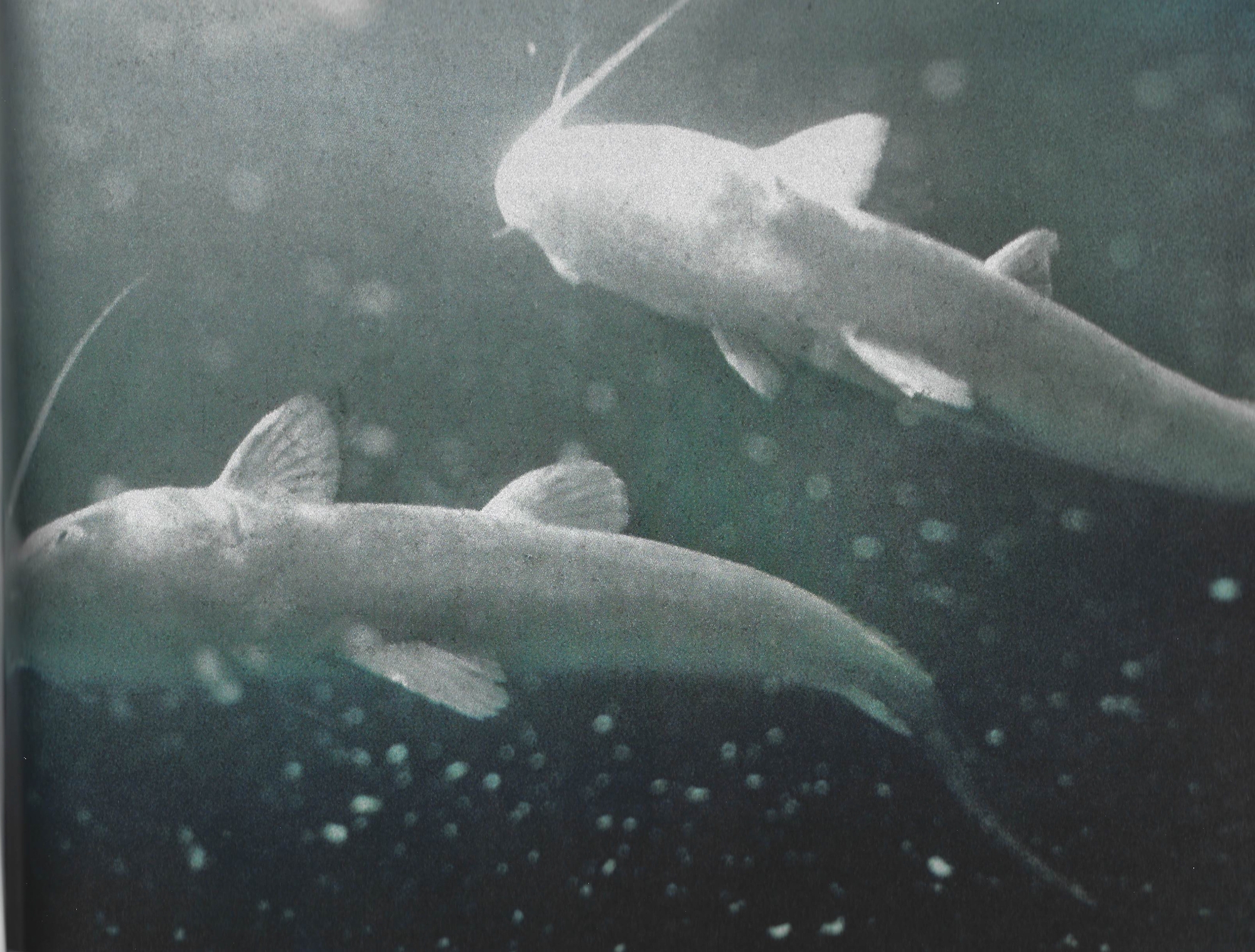
The plan to electrocute the fish in public in preparation for eating by the public was met with outrage. This in turn meant that the ritual and reflective intentions of the work were overwritten with an interpretation as shock art. In fact, Newton tells us that the scandal led Sonnabend Gallery in New York to be interested in representing them, but they turned this down.[25] The Harrisons’ concern was with learning more about the implications of their commitment, and not becoming more successful as producers of shock art.
The third contradiction has to do with success and failure. The last of Stengers’ key questions asks us to pay attention to what changes the criteria in defining success and defeat in an open-ended experimental adventure. The catfish did not mate and reproduce as hoped, “. . . so in the strict ecological sense Portable Fish Farm did not succeed.”[26] In the end this was more important to the Harrisons than its apparent success as an artwork. The failure of this experiment led to Survival Piece #VII The Crab Farm which is a key part of The Lagoon Cycle (1975-85). The contradictions that Crab Farm in turn generated are at the heart of the debate between the two main protagonists in this work, the Lagoon Maker and the Witness in The Lagoon Cycle. In these various ways the Harrisons enable the energy of their processes of encounter and learning to continue to work generatively, rather than dissipate. Failure works for them and towards the next adventure.
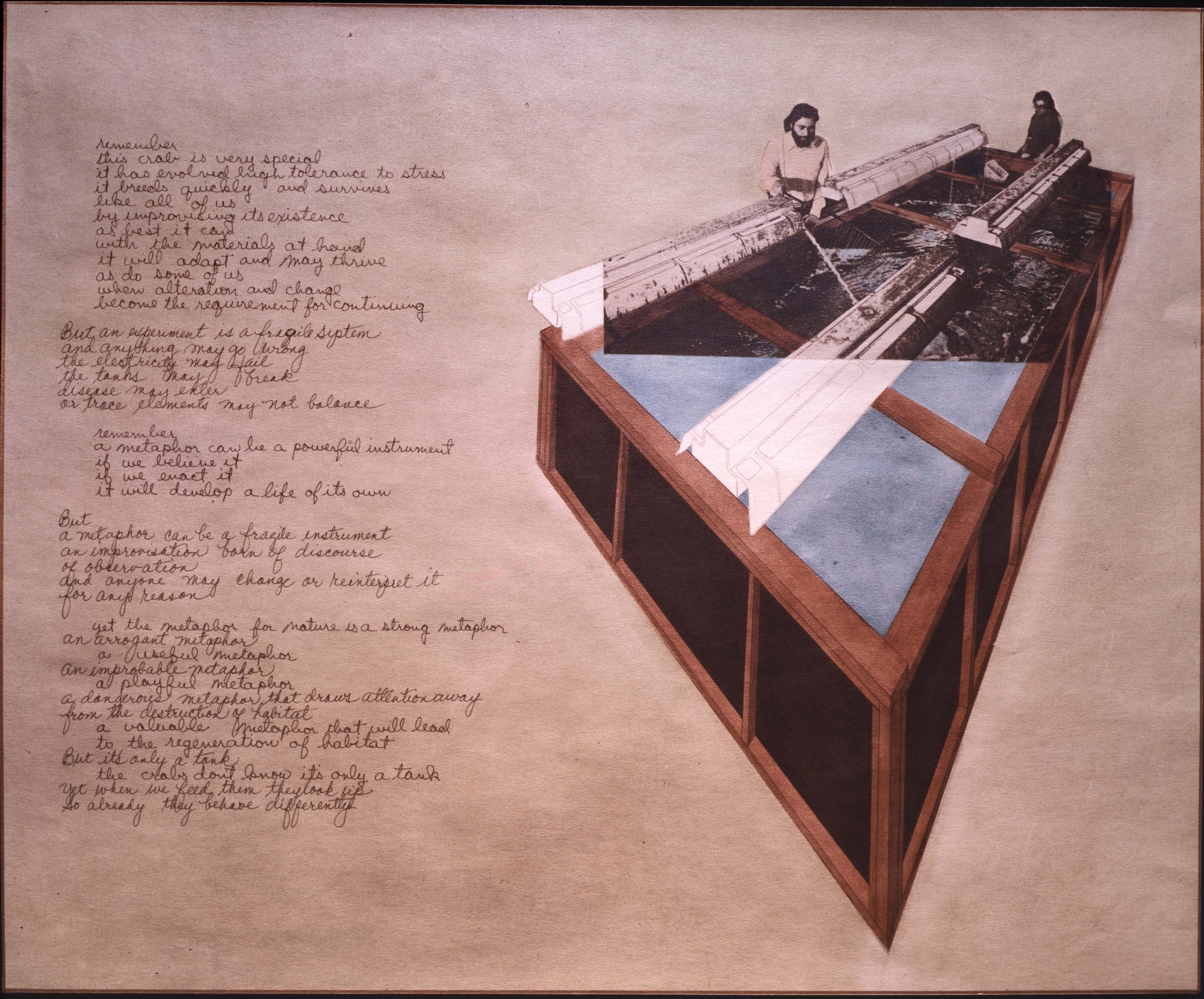
Storytelling
The rigor and creativity implied in the search for a different imaginary that enables us to know the world differently, is closely aligned with the importance of storytelling, a form of creativity that is at the forefront of much ecological thinking. Haraway, drawing on Marilyn Strathern (anthropologist), repeats the refrain,
. . . it matters which stories tell stories, which concepts think concepts. Mathematically, visually and narratively, it matters which figures figure figures, which systems systematize systems. [27]
Progress is a story we have told ourselves for over 500 years, one that is defined by values that are purely human and that has now prompted the previously forbidden question, “What has happened to us?”. Stengers acknowledges how hard it is to give voice to non-human knowledge more ancient than humankind, and in relation to which the human is an “insignificant ripple”. Helen and Newton draw on ethnopoetics as well as the declamatory voice of Judeo-Christian forms of storytelling, the “If. . . “ “then. . . “ construction, to disrupt the story lines of progress.
IF
ACCORDING TO THE LAWS OF THE CONSERVATION OF ENERGY
THE TRANSFER OF ENERGY
FROM ONE FORM TO ANOTHER
GENERATES A NET LOSS
THEN
THE CLEAR CUTTING OF THE OLD GROWTH FOREST
MUST INVOLVE A NET LOSS EQUAL TO MORE
THEN THE ENERGY GAINED
FROM TRANSFORMING IT INTO PROFIT [28]
We can trace this search for a different story for the Harrisons back to an earlier work, an essay they jointly authored in 1965 entitled Dropouts and a ‘Design for Living’. [29] In this essay they address the problems of young people who have fallen out of education by drawing them into questioning the world in which they find themselves. The questions begin with “What are you most afraid of?” and move to “Why is everything as it is? . . . How would you like the world to be? What do you have to do with the world? What does the world have to do with you?”. [30] Their line of questioning moves beyond the expected pragmatic of “How do you get a job?” to embrace desire and the importance of aesthetics in everyday life. The questions go on, “What is the meaning and function of a good environment? Health? Food? Effective childcare? What is the role of the parent? Why use decoration or plan for visual effect? Why plan? How can we handle money? Time? Energy? Leisure? What is the value of continuous inquiry? Why keep an open mind?” (ibid). This is a clear example of Stengers’ observation that asking the question “what has happened to us?” is not the search for an ultimate explanation, but a resource for telling our stories in another way, in a way that situates us otherwise-not as defined by the past, but as able, perhaps, to inherit from it in another way. [31]
Reversing Entropy
What does this work contribute to Steiners’ articulation of the difficulty of reversing entropy? It highlights that the increasingly high entropy in the web of life is driven by human ways of thinking, perhaps in particular the fundamental problem of the “bifurcation of nature” as identified by Stengers/Whitehead and the Harrisons. The moves that both the Harrisons and Stengers/Whitehead make recognize that reversing entropy challenges to the core the way we think, live and practice in the world. We currently accept a construction of “nature” that is split between experience and data, where “how?” questions are separated from “why?” questions. We do not risk forms of research that embrace unintended consequences. We refuse to allow our imaginations to stray towards responsibility to what we understand. Energy rich systems are characterized by diversity and complex interdependencies. We have shown how Stengers’ reading of a series of issues helps us understand the Harrisons’ early works differently. For her this is about lifeforms composing the world together, at the mercy of each other, and sharing fate in life and death. In this she is drawing closely on the evolutionary biologist Lynn Margulis (1938-2011). The question underpinning the Harrisons’ Survival Pieces: How do we feed ourselves? acts as a powerful anchor, refocusing our attention on the conditions for life itself. David Antin, Helen and Newton’s colleague at the University of California, San Diego, said in 1970
The idea of an ecological art is the idea of an art that articulates dependencies: its own condition for existence or those of the world.[32]
Antin uses the term “dependence” and we might think that this has evolved into what is now more frequently interdependence as used by Stengers, Haraway, Latour and others. In fact, Stengers illuminates this difference.
Nor should the intertwining interdependencies be confused with a network of interlinking dependences. It is easy to understand why, without water or light, a plant dies. This fits the definition of ‘dependence’. But interdependence implies a way of being sensitive that is a form of venture. [33]
Dependency is directly related to survival. Stengers is concerned, as are we, with “inextricability”, the intertwining of interdependence which makes the fragmenting methods of technoscience so problematic. Art has the capacity to reveal both dependency and the conditions of survival as well as the intertwining of living things. Stengers also offers us a different and useful reading of interdependence in saying “…letting [our]selves be touched by the reasons of others…”[34] Helen and Newton’s multi-vocal poetics is an example of the thing that does the touching. Stengers’ understanding of “letting ourselves be touched” highlights the importance of the “middle voice” neither the active nor the passive, nor the subject or object. She continues that it is ”…a transversal path connecting the most diverse earthly interdependencies … where touch is not an impact that a being endures but a prerequisite for this being to be affected.” (ibid). This suggests an openness to the potential and risk involved in experience. She demonstrates “the letting ourselves be touched” as a particular construction of interdependence through our sense of taste. “Knowing how to taste is an integral part of the adventure of life in a world that requires of us an ability to discern between what feeds us, what poisons us, and what heals us” (ibid). For Stengers the daring involved in allowing ourselves to touch and be touched is a manifestation of interdependence. It is generative and therefore a particularly suitable way to imagine some forms of art.
Artists Learning from Other Artists
We suggested earlier that Stengers “thinking with” Whitehead and our “thinking with” the Harrisons closely parallels the way in which artists learn from other artists. They do not seek models that are abstracted from another artist’s work and then applied, but rather draw critically on the specificity of an individual approach, testing aspects in new circumstances and relations. Stengers’ construction of “letting ourselves be touched by the reasons of others” is a vivid way to trace the artists from whom the Harrisons have learned and artists that the Harrisons have profoundly influenced in the development of an ecological aesthetic. In either direction it is difficult to trace influence in obvious terms of style or technique. It takes the form of a deep commitment to questioning what one sees in the world. This leads to a transformation in the way an artist approaches their work and connects with other artists and audiences in the life around them. It is the generative power of “seeing” or experiencing the world combined with the responsibility to act on the seeing that Stengers draws attention to.
To make sense in common is not to convert to or submit to, or be shaped by, a common reason but to experience a transformation in our relationships with what is ours, with our reasons for acting, for perceiving things in one way rather than another. [35]
In recent conversations with us as authors, Newton Harrison discussed the artists that were key to his and Helen’s development.[36] He stressed the importance of the questions these artists have posed through their work, questions that challenge fundamental assumptions and beliefs in human relations to their environment. Cézanne, Newton suggests, questioned why he saw vanishing points in 500 years of painting since the Renaissance, but not in real life. He (Cézanne) followed this observation, took risks (responsibility in Stengers’ sense) and generated a very different approach to painting constructed from the spheres, cones and cubes that for him constituted the basic forms in nature. Rembrandt posed the question of how to convey spirituality through an absence of light, reversing the conventions of Western art to that point where spirituality was conventionally evoked by flooding a painting in light. For Helen and her interest in literature, Dickens’ genius lay in the way he was able to vividly engage with a larger field of human behavior through writing. The Harrisons describe this way of “thinking by questioning” as a process of identifying and working with an “ennobling problem”, i.e. issues that are recognized as significant and important to address, whether or not the answer is known, and not just by specialists, but by common consent. In each case the point of the work of art is not to resolve the inconsistencies and contradictions that life presents, but to undertake a process of working them through by creating the circumstances for others to participate.
If that is how the Harrisons were influenced, how in turn has the Harrison’s sharp question, how to do no work that does not attend to the wellbeing of the web of life, been influential on other artists? How do such transformations in turn become generative of a world in common? We will trace these questions through four artistic practices which openly acknowledge the Harrisons’ influence. All four, Reiko Goto and Tim Collins, Lauren Bon, Brandon Ballengée and Cathy Fitzgerald, participated in the “Listening to the Web of Life Interdisciplinary Workshop” (Scripps Institute of Oceanography/La Jolla Heritage Society March 17-18 2022). There are many others who we could have selected as equally relevant, including other artists who presented at the workshop in March and have also had long term relationships with the Harrisons (Lillian Ball and her work with Mangrove restoration informed by the Harrisons’ work The Endangered Meadows of Europe (1994), [37] Betsy Damon and her work with the livingness of water, [38] David Haley and his articulation of a pedagogy of graceful adaptation,[39] and Ruth Wallen with her exploration of grief in the context of heatwave induced wildfires in the forests of the American West).[40]
Reiko Goto Collins and Tim Collins have throughout their careers been friends with and exhibited together with the Harrisons. [41] They share a common cause in committing to making work that interconnects the human relations with the more-than-human. In Goto-Collins’ doctoral phase of research, she worked with Helen Mayer Harrison’s life-long concern with empathy.[42] However Collins and Goto-Collins come from a very different artistic tradition, one characterized by an embodied conceptualism. Over a period of ten years in Pittsburgh they developed watershed scale works (1996-2005), [43] but more recently they have focused on processes of deeply observing systems by attending to particular living things. In Plein Air (2010-ongoing), they use a range of sensor technologies to reveal photosynthesis and transpiration in living trees. Monitoring a single leaf for light, temperature, humidity, and carbon dioxide, data reveal the tree’s reactions to dynamic local atmospheric conditions—changes in that data shape a real time sound that reveals the (otherwise silent) breath of a tree. In their Houyhnhnm work (2016-ongoing) human/animal relations are explored in partnership with their horse, The Darkness. Using GIS as well as walking with The Darkness, they have explored the world as experienced through the horse’s movement and the diet of seasonal and edible plants that The Darkness selects for himself. We can recognize a shared concern for listening to the web of life in these works. Collins and Goto-Collins’ exhibitions and critical writing create a reflective distance that does not resolve the strangeness of encounter that we as humans experience with the non-human, but rather enfolds us in their idiosyncratic processes of uncovering and being present within that strangeness.
Where Goto-Collins and Collins’ work generates a world in common through intimacy, Lauren Bon focuses her project Bending the River (2006—present) on civic processes of governance in relation to access to water as a commons. [44] She has developed an organization, Metabolic Studio, over a number of years through which she explores the potential, alongside other artists, of reconnecting art to public life. Her particular focus on the water systems of Los Angeles is a serious and ambitious effort to reclaim water from privatization and from institutions that serve private interests by tracing, uncovering, and honoring pre-colonial watersheds. She describes Bending the River as an infrastructure work that diverts a small amount of water from the LA river, lifting, cleansing and spreading the water to a network of public parks that formerly constituted the flood plain of the pre-colonial watershed. The large-scale perspective, its sheer “daring” in Stengers’ terms, along with the responsibility Bon and Metabolic Studio have taken over years to challenge civic infrastructure and private interests, is resonant of the Harrisons’ approach. The work carries significant symbolic meaning that challenges the dominance of neoliberal and capitalist interests over common rights to clean water, air and soil. This construction of the commons is particularly evident in Newton Harrison’s recent work in Scotland, The Deep Wealth of this Nation, Scotland (2017-present). He opens the question of how in acknowledging air, water and soil as crucial to supporting life on Earth, we as humans, might take care of these resources by reaching a “commons of mind”. In this spirit Bending the River is a forward-thinking work which is not seeking to restore the floodplain but rather propose a new ecology for the Los Angeles Basin.
Brandon Ballengée’s contribution to the “Listening to the Web of Life” workshop addressed the challenge of putting the well-being of the web of life first in several ways including works exhibited in galleries, work with communities, and experimental sites. [45] The experimental sites focus on the value of Cajun prairie which would have characterized the Louisiana landscape before colonization. A Memory in the Life of a Cajun Prairie is a two-acre site developed in dialogue with Newton Harrison where the potential for prairie to adapt to future climate changes, and in particular the impact of different forms of disturbance (grazing sheep and fire in particular) on carbon sequestration is being studied. Ballengée has introduced sheep as a disturbance as part of the work. In another work concerned with the impact of the BP Deep Water Horizon mega-spill on the Louisiana coast of the Gulf of Mexico, Ballengée focuses on understanding what healthy means in a damaged environment. He examines and reveals how species are adapting to the impacts of the largest oil spill on record. The work Collapse (2012) is in Ballengée’s terms a sketch which models the food chain in the Gulf of Mexico from smaller life forms to large predators. 370 species are represented in the pyramid of specimen jars where empty jars indicate the species that are missing. The work with communities along the Gulf of Mexico coast is as much part of this project as the sculptural installation. He describes the involvement of inhabitants in terms of an exchange in which he learns as much as the participants do, and which is characterized by inspiration rather than didacticism.
Cathy Fitzgerald’s work attends to the web of life through the ongoing transformation of a small plot of commercial plantation forest into permanent species-rich woodland, The Hollywood Forest Story (2008-ongoing), and through the development of a holistic ecological education program, Haumea (2016-ongoing), in collaboration with philosopher Nikos Patedakis, [46] Haumea ‘eco-versity’ demonstrates an approach to re-forming education to embrace complexity, interdependence and co-operation. For Fitzgerald the Harrisons’ focus on transformation is increasingly critical and asks us to go beyond metaphors, as important as they are. Fitzgerald acknowledges a debt to David Haley for his development of the eco-pedagogical potential of the Harrisons’ practice, and to other pioneers including Joseph Beuys and Gregory Bateson. [47] She has led the Irish Green Party as their forestry spokesperson into adopting a policy of promoting “Continuous Cover” forestry. This involves periodic selective thinning so that the integrity of a forest is not damaged, as natural regeneration of trees occurs to replace thinned trees. This approach takes account of the whole ecosystem. This work was directly inspired by the Harrisons and the rigorous articulation of their approach in their own writings and the works themselves. [48] She describes The Serpentine Lattice as “. . . a comprehensive range of methods; steps and processes that I regard as exemplary for eco-social art practice”. [49] Fitzgerald’s use of “Story” in the title of the site-based work, her work to develop policy, and her approach to re-forming education, recognizing that intellectual understanding is insufficient on its own, builds on the Harrisons’ notion of conversational drift and their use of metaphor as key aspects of transformation. [50]
There are a number of ways in which these artists share approaches with the works of the Harrisons including working across multiple scales, challenging existing metaphors, and questioning conventional assumptions of value in the arts. All of these artists share a fundamental belief that aesthetic experience has a critical role to play in sustaining energy and countering its dissipation through the construction of a world in common. We also see in these examples, following on from our analysis of the Harrisons, various configurations of “a leap of imagination,” “inventing a field,” “adventure,” and the meaning of “storytelling”. Each demonstrate the value of the unique perspective engaged with limits or constraints, creating stories that are multi-faceted and that don’t seek to land on a single truth, but have the potential to transform understandings, behaviors and even cultures.
“Could we be Looking at a Society Wherein Every Act of Power Would Require an Equal Act of Generosity?” [51]
We opened this article with a quote from Steiner suggesting that the reversal of entropy demands considerable energy, imagination and risk. Steiner creates a case for ecological aesthetics based predominantly on the importance of beauty in assembling ecological knowledge, proposing that such knowledge has a powerful bearing on our social and cultural relations with the environment. Steiner relies on Ecosystems Services, arguably a framework that is organized by human self-interest. Stengers and the Harrisons call for a deeper level of change, a more fundamental “leap of the imagination” in which it is no longer appropriate to imagine the Earth as a totality of resources available for human use. We now know, they suggest, that the earth, Gaia, is in fact indifferent to human survival and need to forego the hope of technological “fixes”. This is not a crisis in the sense of a transitional period that will be overcome but a permanent part of our future and of the question of whether it will be a future worth living.
What are the implications for an aesthetic? Steiner, Stengers and the Harrisons share the insight that the challenge draws on every aspect of human society, the sciences and the arts with the political, ecological and economic. It is in the coming together of a plurality of perspectives that the issue of the commons becomes crucial:
the brutal demand that all peoples acknowledge they are in the same boat, that they all have to agree to present what they know to each other, but in a way that renders these knowledges ‘politically active’, liable to political reinvention.[52]
Whilst Steiner as a designer comes from the perspective that our task is to create order out of chaos, the Harrisons and Stengers consistently focus on the importance of indeterminacy in any form of change, along with processes of improvisation and emergence that characterize living systems. The Harrisons’ concept of conversational drift is an embodiment of indeterminacy. It captures the way their works start as conversations between them, as artists and generalists, and the people from whom they learn about the ecology of a place. Conversation literally forms the work and the “drift,” like that of a slow-moving glacier, shows how the work of art goes out into the world and has a life of its own. For the Harrisons, the potential for their works to find their own life through others in different contexts, is a key manifestation of conversational drift and its potential to address the making of a world in common through a plurality of perspectives. It is also the taking of responsibility for actions generated from new understandings. For the Harrisons art needs to offer a different world “in common” to the high entropy systems we have created, countering the bifurcation of nature. Art can be characterized by emergence, manifest in the Harrisons’ case as conversational drift, offering the opportunity to improvise a world in common within and with respect for the wellbeing of the web of life.
Anne Douglas is a Professor Emeritus, previously Chair in Art in Public Life at the Robert Gordon University, Aberdeen Scotland. She has focused, over the past 25 years, on developing doctoral/postdoctoral research into the changing nature of art in public life, increasingly in relation to environmental change. She has published on artistic leadership, improvisation and participation through the arts, exploring the function and poetics of exemplary artistic practices. Douglas was the Rome Scholarship in Sculpture (1976-8) and Artist-in-Residence, Accademia Britannica, Rome (1984), and the McGeorge Fellowship, University of Melbourne in 2014.
Chris Fremantle’s focus is the role of the artist in public life particularly in environment and health. He has been an active researcher for fifteen years and completed a PhD by Public Output (2022). Prior to that he received an MLitt in Cultural History from the University of Aberdeen (1990). He has worked for 25 years as a Producer for artists work in public places including bringing the Land Art Generator Initiative to Scotland (2016). Fremantle is currently Lecturer and Research Fellow at Gray’s School of Art, Robert Gordon University.
Notes
1. Frederick Steiner, “Toward an Ecological Aesthetic,” Socio-Ecological Practice Research 1, no. 1 (March 2019): p.36, https://doi.org/10.1007/s42532-018-00004-0.
2. Newton Harrison, ‘Helen’s Town: The Impulse to Begin Again’, Ecopoiesis: Eco-Human Theory and Practice 2, no. 2 (2021): p.63, https://en.ecopoiesis.ru/aktualnoe/news_post/
harrison-newton-helens-town-the-impulse-is-to-begin-again.
3. Helen Mayer Harrison and Newton Harrison, The Time of the Force Majeure: After 45 Years Counterforce Is on the Horizon? (Munich, London, New York: Prestel, 2016), p.426ff.
4. We are coming from the perspective of practice-led researchers and in the end our concern is for practices that can speak to the current times. Over thirty years our research has been concerned with artists and their action in public life. Our research encompasses both attention to exemplary practices such as that of Helen and Newton, as well as experimental work through live projects.
5. Diego Galafassi et al., ‘Raising the Temperature’: The Arts in a Warming Planet’, Current Opinion in Environmental Sustainability 31 (2018), pp.71–79.
6. Amitav Ghosh, The Great Derangement: Climate Change and the Unthinkable (Chicago and London: University of Chicago Press, 2016).
7. Rachel Carson, Silent Spring (Boston, MA: Houghton Mifflin, 1962).
8. Anne Douglas and Chris Fremantle, “Inconsistency and Contradiction: Lessons in Improvisation in the Work of Helen Mayer Harrison and Newton Harrison,” in Elemental: An Arts and Ecology Reader, edited by James Brady (Manchester: Gaia Projects, 2016); Anne Douglas and Chris Fremantle, “What Poetry Does Best: The Harrisons’ Poetics of Being and Acting in the World,” in The Time of the Force Majeure: After 45 Years Counterforce Is on the Horizon, edited by Helen Mayer Harrison and Newton Harrison (New York: Prestel, 2016); Chris Fremantle, Anne Douglas, and Dave Pritchard, “In the Time of Art with Policy: The Practice of Helen Mayer Harrison and Newton Harrison alongside Global Environmental Policy since the 1970s,” in The Routledge Companion to Art in the Public Realm, edited by Cameron Cartiere and Leon Tan (Abingdon, Oxon and New York: Taylor & Francis/Routledge, 2020); Chris Fremantle, Anne Douglas, and Dave Pritchard, “The Harrisons’ Practice in the Context of Global Environmental Policy and Politics from the 1960s to 2019: A Timeline,” in The Routledge Companion to Art in the Public Realm, edited by Cameron Cartiere and Leon Tan (Abingdon, Oxon and New York: Taylor & Francis/Routledge, 2020); Anne Douglas and Chris Fremantle, “Thinking with the Harrisons: What Does Now Demand?,” ZIP, 2022,https://doi.org/10.48526/RGU-WT-1629026; Anne Elizabeth Douglas, ‘Giving Absurdity Form: The Place of Contemporary Art in the Environmental Crisis’, Arts 10, no. 4 (November 30, 2021): 81, https://doi.org/10.3390/arts10040081.
9. Isabelle Stengers, Thinking with Whitehead: A Free and Wild Creation of Concepts (Cambridge, Mass: Harvard University Press, 2011), p.15.
10. Stengers, pp.1–7 referencing John Gardner’s Grendel (London: Robin Clark, 1991).
11. Stengers, p.13.
12. Michael Auping, Common Ground: Five Artists in the Florida Landscape (Sarasota, Fla: John and Mable Ringling Museum of Art, 1982), pp.102–3.
13. Stengers, Thinking with Whitehead, p.22.
14. Stengers, p.19.
15. Helen Mayer Harrison and Newton Harrison, From There to Here (San Diego, California: The Harrison Studio, 2001), n.p.
16. Helen Mayer Harrison and Newton Harrison, The Serpentine Lattice (Portland, Oregon: Douglas F. Cooley Memorial Art Gallery, Reed College, 1993), pp.5–6.
17. Harrison and Harrison, From There to Here, n.p.
18. Harrison and Harrison, The Time of the Force Majeure: After 45 Years Counterforce Is on the Horizon?, p.25.
19. Stengers, Thinking with Whitehead, p.22.
20. Pasi Heikkurinen et al., ‘Organising in the Anthropocene: An Ontological Outline for Ecocentric Theorising’, Journal of Cleaner Production 113 (February 2016): p. 708, https://doi.org/10.1016/j.jclepro.2015.12.016.
21. Stengers, Thinking with Whitehead, p.15.
22. Stengers, p.57.
23. We discuss this specific aspect of the Harrisons’ practice in Douglas, Anne, and Chris Fremantle. ‘Inconsistency and Contradiction: Lessons in Improvisation in the Work of Helen Mayer Harrison and Newton Harrison’. In Elemental: An Arts and Ecology Reader, edited by James Brady (Manchester: Gaia Projects, 2016).
24. John Albert Walker, Art and Outrage: Provocation, Controversy, and the Visual Arts (London: Pluto Press, 1999), pp.52–57.
25. Newton Harrison, “Newton Harrison,” interview by Chris Fremantle and Anne Douglas, December 12, 2019.
26. Harrison and Harrison, The Time of the Force Majeure: After 45 Years Counterforce Is on the Horizon?, p.32.
27. Donna Haraway, Staying with the Trouble: Making Kin in the Chthulucene (Durham and London: Duke University Press, 2016), p.101.
28. Harrison and Harrison, The Serpentine Lattice, p.6.
29. Helen Mayer Harrison and Newton Harrison, ‘Dropouts and a “Design for Living”’, in New Perspectives on Poverty, edited by Arthur B. Shostak and William Gomberg (Englewood Cliffs, New Jersey: Prentice-Hall, 1965), pp.174–78.
30. Harrison and Harrison, p.176.
31. Stengers, Thinking with Whitehead, p.14.
32. David Antin, “Art + Ecology,” ArtNews, November 1970, p.90.
33. Isabelle Stengers, ‘The Earth Won’t Let Itself Be Watched’, in Critical Zones: Observatories for Earthly Politics, ed. Bruno Latour and Peter Weibel (Cambridge, Mass.: The MIT Press, 2020), p.231.
34. Ibid., p.235.
35. Ibid., p.235.
36. Newton Harrison, “On learning from other artists,” interview by Anne Douglas and Chris Fremantle, zoom recording, (February 15, 2022).
37. Lillian Ball, Mangrove Rescuein Bimini: Connecting Art, Restoration and Community, Listening to the Web of Life Workshop, March 17-18, 2022 (San Diego, California, 2022), https://youtu.be/9AywEGYfuV0?t=4672.
38. Igniting Creativity, Complexity in Action, Listening to the Web of Life Workshop, March 17-18, 2022 (San Diego, California, 2022), https://youtu.be/9AywEGYfuV0?t=2543.
39. David Haley, MetaPoiesis: Art That Yields to Life, Listening to the Web of Life Workshop, March 17-18, 2022 (San Diego, California, 2022), https://youtu.be/C52EN5SNjn8?t=4344.
40. Walking with Trees, Listening to the Web of Life Workshop, March 17-18, 2022 (San Diego, California, 2022), https://youtu.be/iF8jUKOm5Jg?t=2025.
41. Heike Strelow, Natural Reality: Artistic Positions Between Nature and Culture (Stuttgart: Daco Verlag, 1999); Sue Spaid, Ecovention: Current Art to Transform Ecologies (Cincinnati: Contemporary Arts Center, 2002); Grant Kester, Ground Works: Environmental Collaboration in Contemporary Art (Pittsburgh, PA: Carnegie Mellon University, 2005); Ideas and Provocations in Environmental Artsworking, Listening to the Web of Life Workshop, March 17-18, 2022 (San Diego, California, 2022), https://youtu.be/J9MGSARetCE?t=2242; Empathic Relationships with Non-Human Others, Listening to the Web of Life Workshop, March 17-18, 2022 (San Diego, California, 2022), https://youtu.be/iF8jUKOm5Jg?t=3567.
42. Reiko Goto-Collins, “Ecology and Environmental Art in Public Place: Talking Tree: Won’t You Take a Minute and Listen to the Plight of Nature?” (PhD thesis., Robert Gordon University, 2012).
43. Nine Mile Run Greenway (1996-1999) https://collinsandgoto.com/nine-mile-run-greenway-project/ and 3 Rivers 2nd Nature (2001-2005) https://collinsandgoto.com/3-rivers-2nd-nature/.
44. Far Ranging Conversations, Listening to the Web of Life Workshop, March 17-18, 2022 (San Diego, California, 2022), https://youtu.be/9AywEGYfuV0?t=10928; Lauren Bon, Power & Public Space 2: Lauren Bon – Bending the River Back to the City, interview by Matthew Blunderfield, July 8, 2022, https://drawingmatter.org/power-public-space-2-lauren-bon-bending-the-river-back-to-the-city.
45. Brandon Ballengée, Searching for Ghosts of the Gulf, Listening to the Web of Life Workshop, March 17-18, 2022 (San Diego, California, 2022), https://youtu.be/J9MGSARetCE?t=6363.
46. Dangerous Creativity: Advancing Transformative Wisdom Based Learning for Sustainable Cultural Renewal from the Haumea Ecoversity, Listening to the Web of Life Workshop, March 17-18, 2022 (San Diego, California, 2022), https://youtu.be/9AywEGYfuV0?t=6353; Cathy Fitzgerald, ‘The Ecological Turn: Living Well with Forests to Articulate Eco-Social Art Practices Using a Guattari Ecosophy and Action Research Framework’ (Ph.D. Thesis, Dublin, Ireland, National College of Art and Design, 2018), https://www.academia.edu/37725286/The_Ecological_Turn_Living_Well_with_Forests_
To_Articulate_Eco_Social_Art_Practices_Using_a_Guattari_Ecosophy_and_Action_Research_
Framework_PhD_by_Practice_thesis_submission_2018_.
47. Dangerous Creativity: Advancing Transformative Wisdom Based Learning for Sustainable Cultural Renewal from the Haumea Ecoversity.
48. Fitzgerald, “The Ecological Turn: Living Well with Forests to Articulate Eco-Social Art Practices Using a Guattari Ecosophy and Action Research Framework,” p.187.
49. Fitzgerald, p.37.
50. Fitzgerald, pp.138–39.
51. Harrison and Harrison, The Time of the Force Majeure: After 45 Years Counterforce Is on the Horizon?, p.430.
52. Isabelle Stengers and Stephen Muecke, Another Science Is Possible: A Manifesto for Slow Science, English edition (Cambridge ; Medford, MA: Polity, 2018), p.151.

